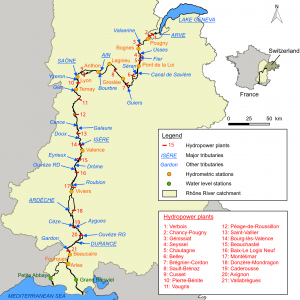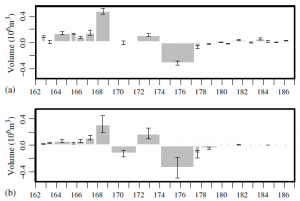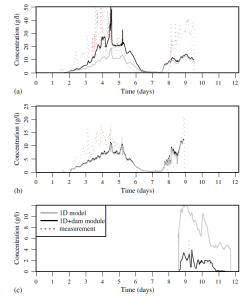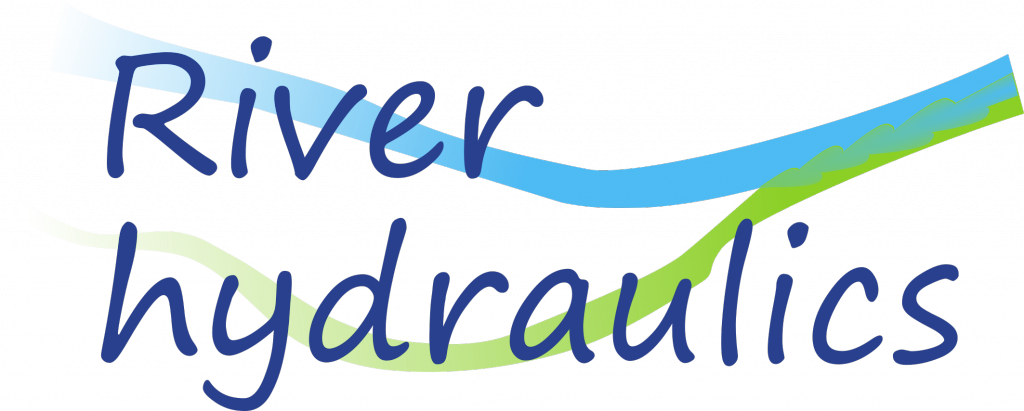Scientific issue
Development of a calculation code allowing hydro-sedimentary calculations to be carried out over long domains (several hundred kilometres) and over the long term (several tens of years). The Mage calculation code solves the one-dimensional Barré-de-Saint-Venant equations; the AdisTS calculation code solves the advection-dispersion equation of a sediment/pollutant concentration with potential exchanges with the bottom via a source term.
Questions scientifiques
- Development of a parallelized calculation code allowing efficient calculation times
- Reflections on the consideration of exchanges at the riverbed/water column interface at the section scale (minor and middle river beds)
- Understanding of the dynamics of fine sediments over a long reach
- Longitidinal grain sorting linked to suspension
Methods and results
- Development of a numerical model of the River Rhône including dam regulation laws (Dugué et al., 2015)

- Development and validation of source terms (erosion, deposition) in the AdisTS code(Guertault et al., 2016), application on the modelling of the Génissiat dam reservoir on the River Rhône during flushing events
Projects
- 2019-2022: ANR DEAR project (Deposition and erosion of fine sediment in Alpine Rivers)
- 2011-2023: Rhône Sediment Observatory (OSR2: 2011-2013, OSR4: 2015-2017, OSR5: 2018-2020, OSR6: 2021-2023)
- 2009-2011: Project Axelera-PCB
Collaborators
- UMR5600, Cerege on the application of Mage on the River Rhône
- CNR, use of Mage-AdisTS on the RIver Rhône, Arc-Isère and Mékong
PhD thesis and postdoctoral projects
- 2019-2022 : Deng J. Dynamique des sédiments fins dans les systèmes de bancs de galets alternés d’une rivière de montagne aménagée. Université C. Bernard, Lyon 1.
- 2012-2015 : Guertault L. Évaluation des processus hydro-sédimentaires d’une retenue de forme allongée : application à la retenue de Génissiat sur le Haut-Rhône. Université C. Bernard, Lyon 1. 240 p.
-
2010-2013 : Antoine G. Dynamique des matériaux en suspension (MES) le long de rivières aménagées : l’Arc en Maurienne et l’Isère. Université Grenoble. 286 p.
Publications
- Vazquez-Tarrio, D., Tal, M., Camenen, B. & Piegay, H. (2019). Changes in bed load transport capacities along a multi-dammed reach over the last 150 years : assessment of causal factors and feedbacks for restoration. Science of the Total Environment, 658:1375-1389.
- Launay, M., Dugué, V., Faure, J.-B., Coquery, M., Camenen, B. & Le Coz J. (2019) Numerical modelling of the suspended particulate matter dynamics in a regulated river network.. Science of the Total Environment, 665:591-605.
- Guertault, L., Camenen B., Peteuil, C., & Paquier, A. (2018). A one-dimensional process-based approach to study reservoir sediment dynamics during management operations. Earth Surface Processes & Landforms, 43(2): 373-386.
- Guertault, L., Camenen B., Peteuil, C., Paquier, A. & Faure, J.-B. (2016). One-dimensional modelling of suspended sediment dynamics in dam reservoirs. J. Hydraulic Eng., 142(10.1061):1-9.
- Launay, M., Le Coz, J., Angot, H., Dramais, G., Andriès, E., Camenen, B., Faure, J.B. & Coquery, M. (2015). Numerical and physical simulation of soluble contaminant transport through complex large river systems. J. Hydro-Environment Res. 9:120-132.
- Dugué, V., Walter, C., Andriès, E., Launay, M., Le Coz, J., Camenen, B. & Faure, J.-B (2015). Accounting for hydropower schemes’ Operation rules in the 1D hydrodynamic modeling of the Rhône river from lake Geneva to the Mediterranean Sea. Proc. 36th IAHR World Congress, La Haye, Pays Bas, June 2015, 8p.




